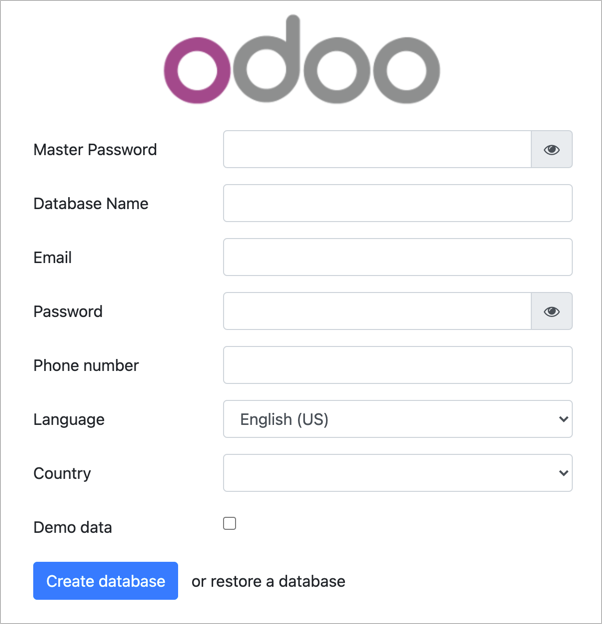How to Install Odoo on Ubuntu 20.04
-
by cobra_admin
- 58
Introduction
Odoo is an open-source, self-hosted ERP business suite with modules for accounting, CRM, sales, purchasing, Point of Sale, E-Commerce, project management, inventory, and more. This guide explains how to install Odoo on Ubuntu 20.04.
Prerequisites
- Deploy a fully updated Ubuntu 20.04 cloud VPS server at Vultr.
- Create a non-root user with sudo access.
- This guide uses example_user as the non-root account.
1. Set Up the Installation Environment
- Connect to your server as the non-root example_user account via SSH.
- Update the system packages.
$ sudo apt update - Install Git.
$ sudo apt install git -y - Install Pip.
$ sudo apt install python3-pip -y - Install other required dependencies.
$ sudo apt install -y build-essential wget python3-dev python3-venv \ python3-wheel libfreetype6-dev libxml2-dev libzip-dev libldap2-dev libsasl2-dev \ python3-setuptools node-less libjpeg-dev zlib1g-dev libpq-dev \ libxslt1-dev libldap2-dev libtiff5-dev libjpeg8-dev libopenjp2-7-dev \ liblcms2-dev libwebp-dev libharfbuzz-dev libfribidi-dev libxcb1-dev - Create a new
odoouser.$ sudo adduser odoo
2. Install and Configure PostgreSQL
- Download and add PostgreSQL Repositories.
$ sudo sh -c 'echo "deb http://apt.postgresql.org/pub/repos/apt/ `lsb_release -cs`-pgdg main" >> /etc/apt/sources.list.d/pgdg.list' $ wget -q https://www.postgresql.org/media/keys/ACCC4CF8.asc -O - | sudo apt-key add - - Install PostgreSQL.
$ sudo apt install postgresql postgresql-contrib -y - Start the database server.
$ sudo systemctl start postgresql - Enable the database server to start automatically on system boot.
$ sudo systemctl enable postgresql - Change the default PostgreSQL password.
$ sudo passwd postgres - Switch to the
postgresuser.$ su - postgres - Create a database user named
odoo.$ createuser odoo - Go to the PostgreSQL interactive shell.
$ psql - Give the database user
odoopermission to create databases.ALTER USER odoo WITH CREATEDB; - Exit the interactive shell.
\q - Return to the non-root example_user account.
$ exit
3. Install Wkhtmltopdf
Wkhtmltopdf is a group of open-source command-line tools for rendering HTML pages into PDF and other image formats. It enables Odoo to print PDF reports.
- Download Wkhtmltopdf from GitHub.
$ sudo wget https://github.com/wkhtmltopdf/packaging/releases/download/0.12.6-1/wkhtmltox_0.12.6-1.bionic_amd64.deb - Install Wkhtmltopdf.
$ sudo apt install ./wkhtmltox_0.12.6-1.bionic_amd64.deb -y
4. Install Odoo
At the time of this writing, Odoo 14 is the latest version.
- Create a directory for Odoo and set the owner to the Odoo user.
$ sudo mkdir -p /opt/odoo/odoo $ sudo chown -R odoo /opt/odoo $ sudo chgrp -R odoo /opt/odoo - Switch to the
odoouser account.$ sudo su - odoo - Clone the Odoo 14 source code from GitHub to
/opt/odoo/odoodirectory.$ git clone https://www.github.com/odoo/odoo --depth 1 --branch 14.0 /opt/odoo/odoo - Create a new Python virtual environment for Odoo.
$ cd /opt/odoo $ python3 -m venv odoo-venv - Activate the virtual environment.
$ source odoo-venv/bin/activate - Install all required Python modules with pip3.
$ pip3 install wheel $ pip3 install -r odoo/requirements.txt - Deactivate the environment.
$ deactivate - Create a new directory for 3rd party add-ons.
$ mkdir /opt/odoo/odoo-custom-addons - Switch back to your non-root example_user account.
$ exit - Create a configuration file.
$ sudo nano /etc/odoo.conf - Add the following code to the file. Change
StrongMasterPasswordto a unique password.[options] ; This is the password that allows database operations: admin_passwd = StrongMasterPassword db_host = False db_port = False db_user = odoo db_password = False addons_path = /opt/odoo/odoo/addons,/opt/odoo/odoo-custom-addons - Close and save the file.
5. Create a Service Unit File
- Create a service unit file called
odoo.service.$ sudo nano /etc/systemd/system/odoo.service - Add the following code to the file. Close and save the file.
[Unit] Description=Odoo14 Requires=postgresql.service After=network.target postgresql.service [Service] Type=simple SyslogIdentifier=odoo PermissionsStartOnly=true User=odoo Group=odoo ExecStart=/opt/odoo/odoo-venv/bin/python3 /opt/odoo/odoo/odoo-bin -c /etc/odoo.conf StandardOutput=journal+console [Install] WantedBy=multi-user.target - Reload system daemon for changes to take effect.
$ sudo systemctl daemon-reload - Start the Odoo service.
$ sudo systemctl start odoo - Enable the service to start on system boot.
$ sudo systemctl enable odoo - Check the service status.
$ sudo systemctl status odoo
6. Access Web Interface
To access the Odoo web interface, navigate to your server’s IP address at port 8069 in your web browser. For example, http://192.0.2.11:8069. You should see the database setup screen:

- Enter the admin_password value you chose in
/etc/odoo.conffor the Master Password field. - Enter the other information as desired for your installation.
Conclusion
You have installed Odoo. You can now access the Dashboard and configure it to begin managing your business.
Introduction Odoo is an open-source, self-hosted ERP business suite with modules for accounting, CRM, sales, purchasing, Point of Sale, E-Commerce, project management, inventory, and more. This guide explains how to install Odoo on Ubuntu 20.04. Prerequisites Deploy a fully updated Ubuntu 20.04 cloud VPS server at Vultr. Create a non-root user with sudo access.…
Introduction Odoo is an open-source, self-hosted ERP business suite with modules for accounting, CRM, sales, purchasing, Point of Sale, E-Commerce, project management, inventory, and more. This guide explains how to install Odoo on Ubuntu 20.04. Prerequisites Deploy a fully updated Ubuntu 20.04 cloud VPS server at Vultr. Create a non-root user with sudo access.…